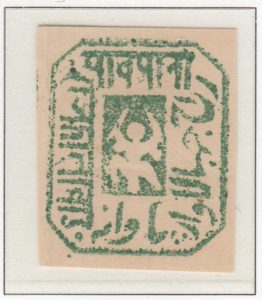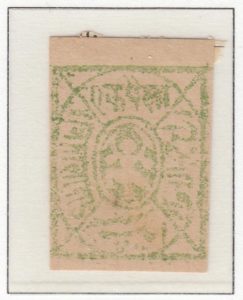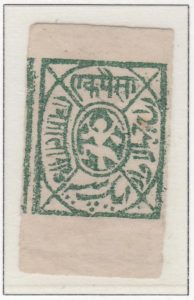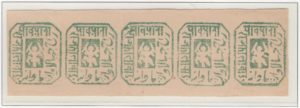
Population: 90,175 (in 1901)
Jhalawar was a Princely state in the Rajputana Agency (presently part of Rajputana state) located in the Hadoti region. The stamps were issued between 1886 and 1890, during the reign of Maharaj Rana Zalim Singh, who governed between 1876 and 1896, when he was deposed.
The stamps were typographed in horizontal strips of twelve. They were imperforate, without gum on laid paper. The stamps became obsolete on November 1, 1900.
Click here to see all stamps from Jhalawar in this exhibition.
History
The origins of Jhalawar, a Rajasthan state, are intimately bound up with nearby Kotar, and illustrate the seesaw nature of rulership and territories of various princely states. Beginning in the late 1700s, the family of Zalim Singh, through its abilities and efforts, came to occupy the post of Diwan at Kotar, which then became hereditary. In fact, the family holder of the post became the de facto ruler of Kotar. But as rulers changed, the Singh family was forced to flee to Mewar, where they again established themselves. Then, returning to Kotar, they assumed the regency there, on behalf of a minor nephew, again making themselves hereditary “mikados.” Kotar was then involved in a rulership struggle between a titular ruler and this “mikado;” unsurprisingly, tensions developed.
Jhalawar was actually the last of the princely states established by the British. In 1838, after countless disputes, the British divided the territory of Kotar into two parts. One part, Jhalawar, was given to the Singh family as hereditary princes. While the first ruler reigned uneventfully and well, the second, adopted, ruler encountered many problems. His apparently childish and bigoted nature, combined with inept administration, prompted the British to remove him in 1896 for mental instability. He was deposed on March 2, 1896 “on account of persistent misgovernment and proven unfitness for the powers of a ruling chief”. The lands of Jhalawar were returned to Kotar.
Yet, in 1899, the British again formed a state of Jhalawar from various provinces of Kotar. The new Jhalawar was only 800 square miles. As the previous ruler had no heirs and refused to adopt, the British chose their own candidate, who proved to be a masterful ruler. Bhawani Singhji (reigning 1899-1929) instituted modernization and many reforms, including schools and libraries. He was devoted to the arts.
He was succeeded by his son (reigning 1929-1943) who instituted such reforms as allowing Harijans (untouchables) to enter temples. He was also a poet. In turn, the next ruler Majaraj Rana Harishchandra had only four years to reign before the State of India was founded. He embraced the change, and served enthusiastically as an elected member of congress, as well as a cabinet minister. However, he opposed the Congress Party during the period in which princely power was being destroyed and assets seized. Although he defeated the Congress Party candidate in an election, he failed to be able to occupy the seat, dying in the middle of the fray.
Jhalawar, although rich in natural resources, is a relatively undeveloped area. Indeed, it is listed as one of the most backward of India’s 640 areas. It was an opium-producing district, with attendant problems of addiction. Oranges are another well known crop, and efforts are being made to substitute this for the more problematic poppy.
Jhalawar
1886



